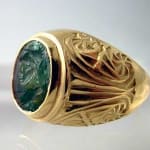Gold Ring with a Roman Emerald Intaglio Depicting the Bust of Minerva, 100 CE - 300 CE
Gold and Emerald
FJ.6677
The art of glyptics, or carving on colored precious stones, is probably one of the oldest known to humanity. Intaglios, gems with an incised design, were made as early as...
The art of glyptics, or carving on colored precious stones, is probably one of the oldest known to humanity. Intaglios, gems with an incised design, were made as early as the fourth and third millennia B.C. in Mesopotamia and the Aegean Islands. The exhibit a virtuosity of execution that suggests an old and stable tradition rooted in the earliest centuries. The tools required for carving gems were simple: a wheel with a belt-drive and a set of drills. Abrasives were necessary since the minerals used were too hard for a metal edge. A special difficulty of engraving intaglios, aside from their miniature size, was that the master had to work with a mirror-image in mind.
Emeralds are a grass-green variety of beryl that are highly valued as a gemstone. The name comes indirectly from the Greek smaragdos, a name that seems to have been given to a number of stones having little in common except their green color. The magnificent hue that gives extraordinary value to this gem is probably due to small amounts of chromium. Many virtues were formerly ascribed to emeralds. When worn, the stone was held to be a preventive measure against epilepsy, and when held in the mouth it was believed to be a cure for dysentery. It was supposed to assist women at childbirth, to drive away evil spirits, and to preserve the chastity of the wearer. Administered internally, it was reputed to have great medicinal value. Its refreshing green color was said to be good for the eyesight
Engraved onto the polished surface of this precious stone is the image of the bust of Minerva, the ancient goddess of wisdom and war known to the Greeks as Athena. She is easily recognizable by her prominent Corinthian helmet that crowns her head. This gorgeous green emerald would have been considered a precious work of art both in its own time as well as today. However, in our hands, having withstood the ravages of time, this seal is even more impressive, a stunning symbol of the wealth, artistry, and history of ancient Rome.
Emeralds are a grass-green variety of beryl that are highly valued as a gemstone. The name comes indirectly from the Greek smaragdos, a name that seems to have been given to a number of stones having little in common except their green color. The magnificent hue that gives extraordinary value to this gem is probably due to small amounts of chromium. Many virtues were formerly ascribed to emeralds. When worn, the stone was held to be a preventive measure against epilepsy, and when held in the mouth it was believed to be a cure for dysentery. It was supposed to assist women at childbirth, to drive away evil spirits, and to preserve the chastity of the wearer. Administered internally, it was reputed to have great medicinal value. Its refreshing green color was said to be good for the eyesight
Engraved onto the polished surface of this precious stone is the image of the bust of Minerva, the ancient goddess of wisdom and war known to the Greeks as Athena. She is easily recognizable by her prominent Corinthian helmet that crowns her head. This gorgeous green emerald would have been considered a precious work of art both in its own time as well as today. However, in our hands, having withstood the ravages of time, this seal is even more impressive, a stunning symbol of the wealth, artistry, and history of ancient Rome.



